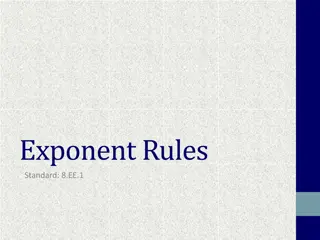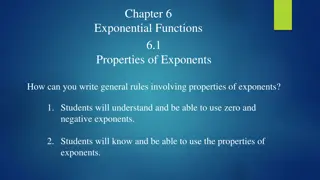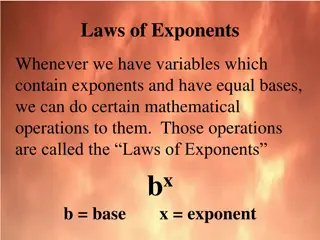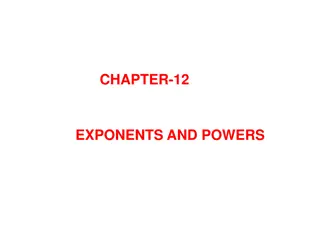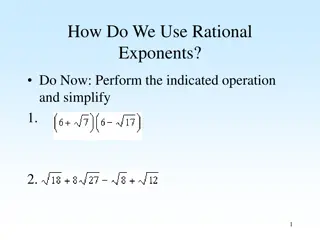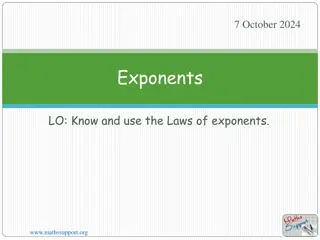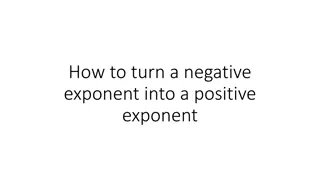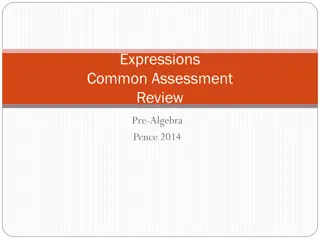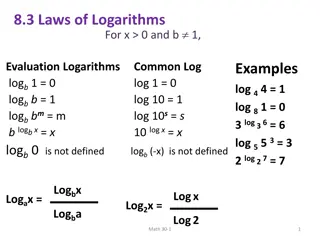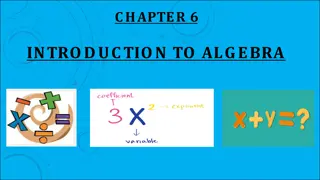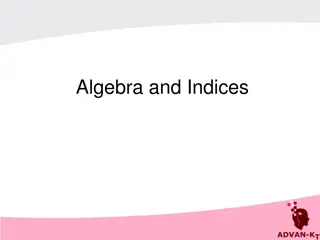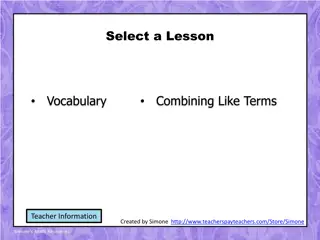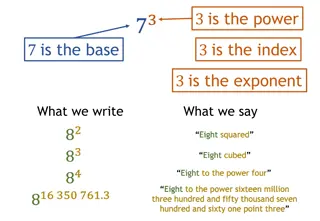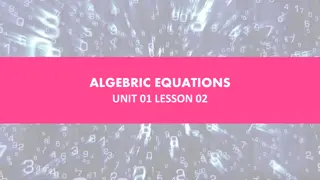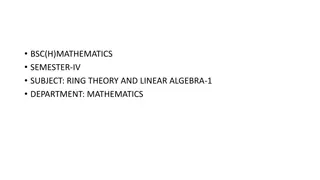Understanding Properties of Exponents in Algebra
Explore the properties of exponents in algebra to simplify expressions and work with scientific notation efficiently. Learn about the zero exponent property, negative exponent property, product property, power of a product property, power of a power property, quotient property, and how to use these properties in calculations. Master the basics of exponents through examples and explanations provided in this comprehensive slideshow.
Download Presentation

Please find below an Image/Link to download the presentation.
The content on the website is provided AS IS for your information and personal use only. It may not be sold, licensed, or shared on other websites without obtaining consent from the author. Download presentation by click this link. If you encounter any issues during the download, it is possible that the publisher has removed the file from their server.
E N D
Presentation Transcript
Polynomials and Polynomial Functions Algebra 2 Chapter 5
This Slideshow was developed to accompany the textbook Larson Algebra 2 By Larson, R., Boswell, L., Kanold, T. D., & Stiff, L. 2011 Holt McDougal Some examples and diagrams are taken from the textbook. Slides created by Richard Wright, Andrews Academy rwright@andrews.edu
5.1 Use Properties of Exponents When numbers get very big or very small, such as the mass of the sun = 5.98 1030 kg or the size of a cell = 1.0 10 6 m, we use scientific notation to write the numbers in less space than they normally would take. The properties of exponents will help you understand how to work with scientific notation.
5.1 Use Properties of Exponents What is an exponent and what does it mean? A superscript on a number. It tells the number of times the number is multiplied by itself. Example; x3 = x x x Exponent Base
5.1 Use Properties of Exponents Properties of exponents ?? ??= ??+? product property x2 x3 = ???= ???? power of a product property (2 x)3 = ?? ?= ??? power of a power property (23)4 = ?? ??= ?? ? quotient property ?4 ?2= ? ? 3 = ? =?? ?? power of a quotient property 4 2
5.1 Use Properties of Exponents ?0= 1 zero exponent property ? ?= 23 = 22 = 21 = 20 = 2-1 = 2-2 = 2-3 = 1 ?? negative exponent property
5.1 Use Properties of Exponents 5-4 53 = ((-3)2)3 = (32x2y)2 =
5.1 Use Properties of Exponents 5?2? 3 8? 4 4? 3?2 10? 2?0= 12?5?2 2?4 2? 3?2
5.1 Use Properties of Exponents To multiply or divide scientific notation think of the leading numbers as the coefficients and the power of 10 as the base and exponent. Example: 2 102 5 103=
5.2 Evaluate and Graph Polynomial Functions Large branches of mathematics spend all their time dealing with polynomials. They can be used to model many complicated systems.
5.2 Evaluate and Graph Polynomial Functions Polynomial in one variable Function that has one variable and there are powers of that variable and all the powers are positive 4x3 + 2x2 + 2x + 5 100x1234 25x345 + 2x + 1 2/x 3xy2 Not Polynomials in one variable.
5.2 Evaluate and Graph Polynomial Functions Degree Highest power of the variable What is the degree? 4x3 + 2x2 + 2x + 5
5.2 Evaluate and Graph Polynomial Functions Types of Polynomial Functions Degree Type 0 Constant y = 2 1 Linear y = 2x + 1 2 Quadratic y = 2x2 + x 1 3 Cubic y = 2x3 + x2 + x 1 4 Quartic y = 2x4 + 2x2 1
5.2 Evaluate and Graph Polynomial Functions Functions f(x) = 4x3 + 2x2 + 2x + 5 means that this polynomial has the name f and the variable x f(x) does not mean f times x! Direct Substitution Example: find f(3)
5.2 Evaluate and Graph Polynomial Functions Synthetic Substitution Example: find f(2) if f(y) = -y6 + 4y4 + 3y2 + 2y Coefficients with placeholders 2 -1 0 -2 -2 4 -4 0 0 0 0 3 0 3 2 6 8 0 16 16 -1 f(2) = 16
5.2 Evaluate and Graph Polynomial Functions End Behavior Polynomial functions always go towards or - at either end of the graph Leading Coefficient + Leading Coefficient - Even Degree Odd Degree Write f(x) + as x - and f(x) + as x +
5.2 Evaluate and Graph Polynomial Functions Graphing polynomial functions Make a table of values Plot the points Make sure the graph matches the appropriate end behavior
5.2 Evaluate and Graph Polynomial Functions Graph f(x) = x3 + 2x 4
5.3 Add, Subtract, and Multiply Polynomials Adding, subtracting, and multiplying are always good things to know how to do. Sometimes you might want to combine two or more models into one big model.
5.3 Add, Subtract, and Multiply Polynomials Adding and subtracting polynomials Add or subtract the coefficients of the terms with the same power. Called combining like terms. Examples: (5x2 + x 7) + (-3x2 6x 1) (3x3 + 8x2 x 5) (5x3 x2 + 17)
5.3 Add, Subtract, and Multiply Polynomials Multiplying polynomials Use the distributive property Examples: (x 3)(x + 4) (x + 2)(x2 + 3x 4)
5.3 Add, Subtract, and Multiply Polynomials (x 1)(x + 2)(x + 3)
5.3 Add, Subtract, and Multiply Polynomials Special Product Patterns Sum and Difference (a b)(a + b) = a2 b2 Square of a Binomial (a b)2 = a2 2ab + b2 Cube of a Binomial (a b)3 = a3 3a2b + 3ab2 b3
5.3 Add, Subtract, and Multiply Polynomials (x + 2)3 (x 3)2
5.4 Factor and Solve Polynomial Equations A manufacturer of shipping cartons who needs to make cartons for a specific use often has to use special relationships between the length, width, height, and volume to find the exact dimensions of the carton. The dimensions can usually be found by writing and solving a polynomial equation. This lesson looks at how factoring can be used to solve such equations.
5.4 Factor and Solve Polynomial Equations How to Factor Greatest Common Factor Comes from the distributive property If the same number or variable is in each of the terms, you can bring the number to the front times everything that is left. 3x2y + 6xy 9xy2 = 1. Look for this first!
5.4 Factor and Solve Polynomial Equations 2. Check to see how many terms Two terms Difference of two squares: a2 b2 = (a b)(a + b) 9x2 y4 = Sum of Two Cubes: a3 + b3 = (a + b)(a2 ab + b2) 8x3 + 27 = Difference of Two Cubes: a3 b3 = (a b)(a2 + ab + b2) y3 8 =
5.4 Factor and Solve Polynomial Equations Three terms General Trinomials ax2 + bx + c 1. Write two sets of parentheses ( )( ) 2. Guess and Check 3. The Firsts multiply to make ax2 4. The Lasts multiply to make c 5. The Outers + Inners make bx x2 + 7x + 10 = x2 + 3x 18 = 6x2 7x 20 =
5.4 Factor and Solve Polynomial Equations Four terms Grouping Group the terms into sets of two so that you can factor a common factor out of each set Then factor the factored sets (Factor twice) b3 3b2 4b + 12 =
5.4 Factor and Solve Polynomial Equations Try factoring more! Examples: a2x b2x + a2y b2y = 3.
5.4 Factor and Solve Polynomial Equations 3a2z 27z = n4 81 =
5.4 Factor and Solve Polynomial Equations Solving Equations by Factoring Make = 0 Factor Make each factor = 0 because if one factor is zero, 0 time anything = 0
5.4 Factor and Solve Polynomial Equations 2x5 = 18x
5.5 Apply the Remainder and Factor Theorems So far we done add, subtracting, and multiplying polynomials. Factoring is similar to division, but it isn t really division. Today we will deal with real polynomial division.
5.5 Apply the Remainder and Factor Theorems Long Division Done just like long division with numbers ?4+2?2 ?+5 ?2 ?+1
5.5 Apply the Remainder and Factor Theorems ?3+4?2 3?+10 ?+2
5.5 Apply the Remainder and Factor Theorems Synthetic Division Shortened form of long division for dividing by a binomial Only when dividing by (x r)
5.5 Apply the Remainder and Factor Theorems Synthetic Division Example: (-5x5 -21x4 3x3 +4x2 + 2x +2) / (x + 4) Coefficients with placeholders -4 -5 -21 20 -1 -3 4 1 4 -4 0 6 ? + 4 2 0 2 2 -8 -6 -5 5?4 ?3+ ?2+ 2 +
5.5 Apply the Remainder and Factor Theorems (2y5 + 64)(2y + 4)-1 2 + + + + 5 5 64 4 32 2 32 -32 0 y y 2 0 -8 -8 y y -2 1 0 -2 -2 0 4 4 0 16 16 1 y4 2y3 + 4y2 8y + 16
5.5 Apply the Remainder and Factor Theorems Remainder Theorem if polynomial f(x) is divided by the binomial (x a), then the remainder equals f(a). Synthetic substitution Example: if f(x) = 3x4 + 6x3 + 2x2 + 5x + 9, find f(9) Use synthetic division using (x 9) and see remainder.
5.5 Apply the Remainder and Factor Theorems The Factor Theorem The binomial x a is a factor of the polynomial f(x) iff f(a) = 0
5.5 Apply the Remainder and Factor Theorems Using the factor theorem, you can find the factors (and zeros) of polynomials Simply use synthetic division using your first zero (you get these off of problem or off of the graph where they cross the x-axis) The polynomial answer is one degree less and is called the depressed polynomial. Divide the depressed polynomial by the next zero and get the next depressed polynomial. Continue doing this until you get to a quadratic which you can factor or use the quadratic formula to solve.
5.5 Apply the Remainder and Factor Theorems Show that x 2 is a factor of x3 + 7x2 + 2x 40. Then find the remaining factors.
5.6 Find Rational Zeros Rational Zero Theorem Given a polynomial function, the rational zeros will be in the form of p/q where p is a factor of the last (or constant) term and q is the factor of the leading coefficient.
5.6 Find Rational Zeros List all the possible rational zeros of f(x) = 2x3 + 2x2 - 3x + 9
5.6 Find Rational Zeros Find all rational zeros of f(x) = x3 - 4x2 - 2x + 20
5.7 Apply the Fundamental Theorem of Algebra When you are finding the zeros, how do you know when you are finished? Today we will learn about how many zeros there are for each polynomial function.
5.7 Apply the Fundamental Theorem of Algebra Fundamental Theorem of Algebra A polynomial function of degree greater than zero has at least one zero. These zeros may be imaginary however. There is the same number of zeros as there is degree you may have the same zero more than once though. Example x2 + 6x + 9=0 (x + 3)(x + 3)=0 zeros are -3 and -3
5.7 Apply the Fundamental Theorem of Algebra Complex Conjugate Theorem If the complex number a + bi is a zero, then a bi is also a zero. Complex zeros come in pairs Irrational Conjugate Theorem If ? + ? is a zero, then so is ? ?
5.7 Apply the Fundamental Theorem of Algebra Given a function, find the zeros of the function. ? ? = ?3 7?2+ 16? 10


